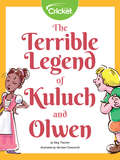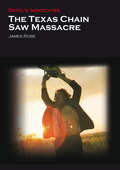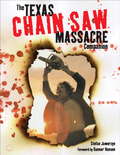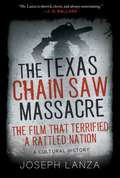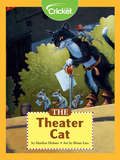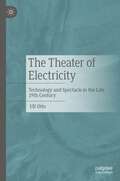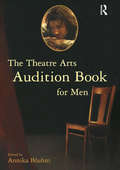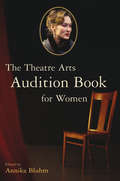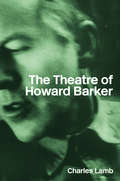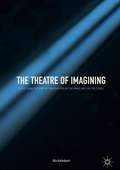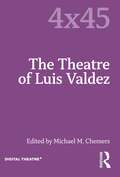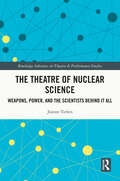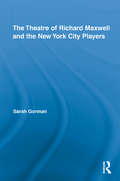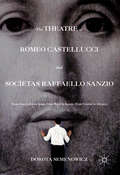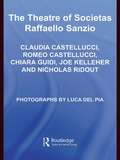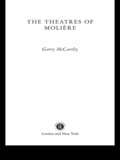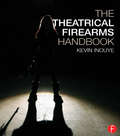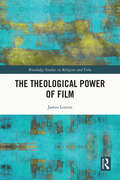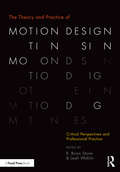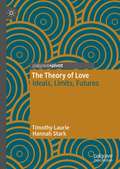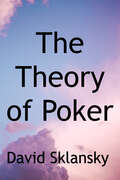- Table View
- List View
The Terrible Legend of Kuluch and Olwen
by Meg ThacherPrince Kuluch has been cursed by his evil stepmother! Now he is in love with the daughter of a giant. Follow Kuluch as he completes the list of tasks from the giant with the help of knights, King Arthur, and even ants! Will he be able to marry the love of his life?
The Terrible Tryouts (Bad News Ballet #1)
by Jahnna N. Malcolm[from the back cover] "Who thought they'd be friends? McGee, Gwen, Mary Bubnik, Zan, and Rocky are five misfit ballerinas. Zan would rather be reading a good book, and Mary Bubnik is a dancing klutz. Gwen prefers Twinkles to plies; McGee's busy with her ice hockey team...and Rocky is just too cool for leotards and pink tights. Too bad their mothers think ballet is good for them. The girls would never have been friends...if they hadn't gotten stuck together trying out for parts in a professional ballet! Can McGee and her new friends turn themselves into real ballerinas? They'd better--or it's bad news for the gang and their ballet!" This is just the beginning of the funny situations of these ballet school friends who like each other more than they like ballet. The Bookshare collection has the whole series. Check out #2 Battle of the Bunheads, #3 Stupid Cupids, #4 Who Framed Mary Bubnik, #5 Blubberina, #6 Save D.A.D., #7 The King and Us, #8 Camp Clodhopper, #9 Boo Who?, and #10 A Dog Named Toe Shoe, with more to come.
The Texas Chain Saw Massacre
by James RoseAs well as providing a summary of the making of the film, James Rose discusses the extraordinary censorship history of the film in the UK (essentially banned for two decades) and provides a detailed textual analysis of the film
The Texas Chain Saw Massacre
by James RoseNo-one who has ever seen the original The Texas Chain Saw Massacre (1974) is ever likely to forget the experience. An intense fever dream (or nightmare), it is remarkable for its sense of sustained threat and depiction of an insane but nonetheless (dys)functional family on the furthest reaches of society who have regressed to cannibalism in the face of economic hardship. As well as providing a summary of the making of the film, James Rose discusses the extraordinary censorship history of the film in the UK (essentially banned for two decades) and provides a detailed textual analysis of the film with particular reference to the concept of 'the Uncanny'. He also situates the film in the context of horror film criticism (the 'Final Girl' character) and discusses its influence and subsequent sequels and remakes.
The Texas Chain Saw Massacre
by Stefan JaworzynIn 1974, a low-budget, no-star horror movie was unleashed on the world, causing panic among the censors and provoking glee from its intended audience. The Texas Chain Saw Massacre is still as powerful today as when it was first seen almost thirty years ago, and will return to the screens in a high profile remake this Halloween. Now, in this long-awaited companion to Tobe Hooper's groundbreaking film, Stefan Jaworzyn gives us the inside story of one of the most successful, controversial and influential horror films ever made, as well as in-depth coverage of the three sequels, various documentaries and other movies also based on the life of serial killer Ed Gein. Packed with exclusive interviews, rare and unseen pictures, and with a foreword from the chainsaw-wielding Leatherface himself, Gunnar Hansen!
The Texas Chain Saw Massacre (Devil's Advocates Ser.)
by James RoseNo-one who has ever seen the original The Texas Chain Saw Massacre (1974) is ever likely to forget the experience. An intense fever dream (or nightmare), it is remarkable for its sense of sustained threat and depiction of an insane but nonetheless (dys)functional family on the furthest reaches of society who have regressed to cannibalism in the face of economic hardship. As well as providing a summary of the making of the film, James Rose discusses the extraordinary censorship history of the film in the UK (essentially banned for two decades) and provides a detailed textual analysis of the film with particular reference to the concept of 'the Uncanny’. He also situates the film in the context of horror film criticism (the 'Final Girl’ character) and discusses its influence and subsequent sequels and remakes.
The Texas Chain Saw Massacre: The Film That Terrified a Rattled Nation
by Joseph LanzaWhen Tobe Hooper’s low-budget slasher film, The Texas Chainsaw Massacre, opened in theaters in 1974, it was met in equal measure with disgust and reverence. The film—in which a group of teenagers meet a gruesome end when they stumble upon a ramshackle farmhouse of psychotic killers—was outright banned in several countries and was pulled from many American theaters after complaints of its violence. Despite the mixed reception from critics, it was enormously profitable at the domestic box office and has since secured its place as one of the most influential horror movies ever made. In The Texas Chainsaw Massacre and Its Terrifying Times, cultural critic Joseph Lanza turns his attentions to the production, reception, social climate, and impact of this controversial movie that rattled the American psyche. Joseph Lanza transports the reader back to the tumultuous era of the 1970s defined by political upheaval, cultural disillusionment, and the perceived decay of the nuclear family in the wake of Watergate, the onslaught of serial killers in the US, as well as mounting racial and sexual tensions. The Texas Chainsaw Massacre and Its Terrifying Times sets the themes of the film against the backdrop of the political and social American climate to understand why the brutal slasher flick connected with so many viewers. As much a book about the movie as the moment, Joseph Lanza has created an engaging and nuanced work that grapples with the complications of the American experience.
The Theater Cat
by Marilyn HelmerFor generations, the LeChats had kept the mouse problem in the Old Lighthouse Theater under control. But Purrcey LeChat doesn't want to hunt mice—he wants to see his name up in lights!
The Theater of Electricity: Technology and Spectacle in the Late 19th Century
by Ulf OttoSince the 1880s, electrical energies started circulating in European theaters, generated from fossil fuels in urban power plants. A mysterious force, which was still traded as romantic life force by some and for others had already come to stand in for progress, entered performance venues. Engineering knowledge, control techniques and supply chains changed fundamentally how theater was made and thought of. The mechanical image machine from Renaissance and Baroque times was transformed into a thermodynamic engine. Modern theater turned out to be electrified theater. – Retracing what happened backstage before the Avantgarde took to the front stage, this book proposes to write the genealogy of theaters modernity as a cultural history of theater technology.
The Theatre Arts Audition Book for Men
by Annika BluhmFirst Published in 2003. Routledge is an imprint of Taylor & Francis, an informa company.
The Theatre Arts Audition Book for Women
by Annika BluhmFirst Published in 2003. Routledge is an imprint of Taylor & Francis, an informa company.
The Theatre of Howard Barker
by Charles LambIn this second, fully revised edition of his acclaimed study of Barker's work, Charles Lamb sets out to make emotional sense of the characters and their interactions. This is a detailed exploration of the 'scene of seduction' - the challenge, the secret, the abject and the catastrophic, processes which dominate Barker's work. For Lamb, the power of Barker's plays is to be found in the exposure to the irrational and its promotion of a state of unknowing. This revised edition includes: * a new interview with Barker;* a revised introduction, * an updated bibliography * a full production chronology. For students of Barker and for actors and directors working with this unique material, Lamb's book is a vital and illuminating text.
The Theatre of Imagining: A Cultural History of Imagination in the Mind and on the Stage
by Ulla KallenbachThis book is the first comprehensive analysis of the fascinating and strikingly diverse history of imagination in the context of theatre and drama. Key questions that the book explores are: How do spectators engage with the drama in performance, and how does the historical context influence the dramaturgy of imagination? In addition to offering a study of the cultural history and theory of imagination in a European context including its philosophical, physiological, cultural and political implications, the book examines the cultural enactment of imagination in the drama text and offers practical strategies for analyzing the aesthetic practice of imagination in drama texts. It covers the early modern to the late modernist period and includes three in-depth case studies: William Shakespeare’s Macbeth (c.1606); Henrik Ibsen’s A Doll’s House (1879); and Eugène Ionesco’s The Killer (1957).
The Theatre of Les Waters: More Like the Weather
by Scott T. CummingsThe Theatre of Les Waters: More Like the Weather combines original writings from Les Waters with short essays by a wide range of his collaborators, creating a personal and multi-faceted portrait of an influential director, revered mentor, and inspirational theatre artist. The book begins with a critical introduction of Waters’s work, followed by essays written by a wide range of Waters's collaborators over the past four decades. These essays are framed by shorter pieces of writing by Waters himself: reflections, inspirations, observations, and personal anecdotes. At the heart of this book lies the notion that the director’s central position in theatrical production is defined by collaboration and that a study of directing should take into account how a director works with playwrights, designers, actors, stage managers, and dramaturgs to turn artistic vision into concrete reality on stage. An insightful resource for early career or student directors in theatre programs, The Theatre of Les Waters sheds light on the art of theatre directing by exploring the work of a major theatre artist whose accomplished career sits at the heart of American theatre in the 21st century. Drawing on aspects of memoir, case study, interview, miscellany, biography, and criticism, this is also an enlightening read for anyone with an interest in how theatre artists bring their creative vision to life.
The Theatre of Luis Valdez (4x45)
by Michael M. ChemersThe Theatre of Luis Valdez focuses on the life and work of American playwright and director Luis Valdez, probably best known for his landmark 1979 play Zoot Suit – the first play by a Latinx playwright to appear on Broadway – and founder of El Teatro Campesino, the oldest surviving community theatre in the United States. Built around first-hand discussions of Valdez’s work, this collection gives an in-depth understanding of where ‘the godfather of Chicano theatre’ fits in the grand scheme of American drama and performance. Collaborators Edward James Olmos and Alma Martinez talk about working with Valdez and El Teatro Campesino; scholar Leticia Garcia interviews Jorge Huerta, the leading authority on Chicanx and Latinx theatre on the impact of Valdez work; and Luis Valdez himself contributes a lecture on all aspects of his craft from political resistance and the migrant experience to actor training and dramatic form. A concise and accessible study, 4x45 || Luis Valdez is the go-to resource for scholars, students and theatre practitioners looking for an introduction to this seminal figure in modern American performance.
The Theatre of Nuclear Science: Weapons, Power, and the Scientists Behind it All (Routledge Advances in Theatre & Performance Studies)
by Jeanne P TiehenThe Theatre of Nuclear Science theoretically explores theatrical representations of nuclear science to reconsider a science that can have consequences beyond imagination. Focusing on a series of nuclear science plays that span the twentieth and twenty-first centuries, and including performances of nuclear science in museums, film, and media, Jeanne Tiehen argues why theatre and its unique qualities can offer important perspectives on this imperative topic. This book will be of great interest to students and scholars of theatre, politics, and literature.
The Theatre of Richard Maxwell and the New York City Players (Routledge Advances in Theatre & Performance Studies)
by Sarah GormanThe theatre of Richard Maxwell and the New York City Players has received significant international recognition over the past ten years. The company has received three OBIEs, for House (1999), Drummer Wanted (2002) and Good Samaritans (2005). Maxwell received a Guggenheim Fellowship in 2010 and has been commissioned by venues in the United States, the United Kingdom, Germany, Austria, the Netherlands, France, Belgium and Ireland. Although his productions generate a plethora of reviews, there is a deficit of material providing a critical and sustained engagement with his work. The aim of this book is to provide a critical survey of Maxwell’s work since 1992, including his early participation in Cook County Theater Department. Touching upon the acting, production and rehearsal processes of NYC Player’s work, and Maxwell's representations of space, community, race, and gender, this volume provides scholars with an important overview of a key figure in contemporary drama.
The Theatre of Romeo Castellucci and Socìetas Raffaello Sanzio: From Icon to Iconoclasm, From Word to Image, From Symbol to Allegory
by Dorota SemenowiczThis book focuses on Romeo Castellucci’s theatrical project, exploring the ethical and aesthetic framework determined by his reflection on the nature of the image. But why does a director whose fundamental artistic tool is the image deny this key conceptual notion? Rooted in his conscious distancing from iconoclasm in the 1980s, Castellucci frequently replaces this notion with the words ‘symbol’, ‘form’ and ‘idea’.
The Theatre of Societas Raffaello Sanzio
by Nicholas Ridout Joe Kelleher Claudia Castellucci Chiara Guidi Romeo CastellucciThe Theatre of Socìetas Raffaello Sanzio chronicles four years in the life of an extraordinary Italian theatre company whose work is widely recognized as some of the most exciting theatre currently being made in Europe. In the first English-language book to document their work, company founders, Claudia Castellucci, Romeo Castellucci and Chiara Guidi, discuss their approach to theatre making with Joe Kelleher and Nicholas Ridout. At the centre of the book is a detailed exploration of the company's eleven episode cycle of tragic theatre, Tragedia Endogonida (2002–2004,) including: production notes and extensive correspondence giving insights into the creative process essays by and conversations with company members alongside critical responses by their two co-authors seventy-two photographs of the company's work. This is a significant collection of theoretical and practical reflections on the subject of theatre in the twenty-first century, and an indispensible written and visual document of the company's work.
The Theatres of Moliere (Theatre Production Studies)
by Gerry McCarthy Gerry MccarthyMoliere's plays are the cornerstone of the French Classical dramatic repertoire. Adapted and exploited in his day by dramatists of the English Restoration, they are now again growing in popularity. In this detailed and fascinating volume, Gerry McCarthy examines the practice and method of possibly the greatest actor-dramatist. From the rough farces of Moliere's days on the road to the creation of the diverse and spectacular court entertainments on his return to Paris, McCarthy sheds new light on the dramatic intelligence and theatrical understanding of Moliere's writing for the actor. Drawing on Moliere's own brief discussions of performance and the contemporary evidence of his practice, this is a crucial addition to the debate on style and method in classical acting and on the staging of classical plays on the contemporary stage.
The Theatrical Firearms Handbook
by Kevin InouyeThe Theatrical Firearms Handbook is the essential guide to navigating the many decisions that are involved in the safe and effective use of firearm props for both the stage and screen. It is an invaluable resource for fight choreographers, props designers, backstage crew, directors, actors, stage managers, and more, at all levels of experience. Written in an informal and entertaining manner, with over 100 illustrations, it establishes baseline safety protocol while empowering performers and designers to tell their story of conflict in a way that makes the most of both established convention and current tools of the trade. Within these pages you'll find practical instruction couched in the language of theatre and film, making firearms technology and concepts approachable to dramatic artists without any dumbing-down of the subject material. This handbook is equally at home within the worlds of academic training, professional performance, and independent or community theatre and video productions.
The Theological Power of Film (Routledge Studies in Religion and Film)
by James LorenzThis book explores the theological power of film and seeks to render a properly theological account of cinematic art. It considers: What theology and theological practice does cinematic art give rise to? What are the perceptual and affective potentials of film for theology, and what, if anything, is theological about the cinematic medium itself? The author argues that film is a fundamentally embodied art form, a haptic and somatic medium of perception-cum-expression. This, combined with the distinct temporal aesthetic of film, invests cinema with profound theological potentials. The chapters explore these potentials through theological-cinematic analysis, emphasising the themes of encounter, embodiment, time, and contemplation, as well as three intimately connected doctrines of Christian theology: creation, incarnation, and eschatology. Throughout the book, the films and writings of the Russian director Andrei Tarkovsky emerge as a singular illustration of the theological power of film, becoming a crucial resource for theologicalcinematic analysis.
The Theory and Practice of Motion Design: Critical Perspectives and Professional Practice
by R. Brian Stone Leah WahlinThis collection offers an expansive, multiplatform exploration of the rapidly-expanding area of motion design and motion graphics, taking into account both theoretical questions and creative professional practice. Spanning interaction design, product interfaces, kinetic data visualizations, typography, TV and film title design, brand building, narrative storytelling, history, exhibits and environments, editors R. Brian Stone and Leah Wahlin offer an interdisciplinary range of academic essays and professional interviews that together form a dialogue between motion design theory and professional practice. Written for both those critically engaged with motion design as well as those working or aspiring to work professionally in the field, the book features a range of international contributors and interviews with some of the best-known designers in the field, including Kyle Cooper, Karin Fong, and Daniel Alenquer. The Theory and Practice of Motion Design seeks to illuminate the diverse, interdisciplinary field of motion design by offering a structured examination of how motion design has evolved, what forces define our current understanding and implementation of motion design, and how we can plan for and imagine the future of motion design as it unfolds. An accompanying online resource site, www.motionresource.com, contains visual representations of the examples described in the text.
The Theory of Love: Ideals, Limits, Futures
by Hannah Stark Timothy LaurieThe Theory of Love: Ideals, Limits, Futures explores stories about love that recuperate a vision of intimate life as a resource for creating bonds beyond heterosexual coupledom. This book offers a variety of ethical frames through which to understand changing definitions of love, intimacy, and interdependency in the context of struggles for marriage equality and the increasing recognition of post-nuclear forms of kinship and care. It commits to these post-nuclear arrangements, while pushing beyond the false choice between a politics of collective action and the celebration of deeply personal and incommunicable pleasures. In exploring the vicissitudes of love across contemporary philosophy, politics, film, new media, and literature, The Theory of Love: Ideals, Limits, Futures develops an original post-sentimental concept of love as a way to explain emergent intimacies and affiliations beyond the binary couple.This book will appeal to academics and postgraduate students across the humanities and social sciences, as well as being a teachable resource for undergraduate students. It will appeal to a wide range of academics and students in literary and film studies, philosophy, gender and sexuality studies, and critical and cultural studies.
The Theory of Poker: A Professional Poker Player Teaches You How to Think Like One
by David SklanskyDiscusses theories and concepts applicable to nearly every variation of the game, including five-card draw (high), seven-card stud, hold 'em, lowball draw, and razz (seven-card lowball stud). <p><p>This book introduces you to the Fundamental Theorem of Poker, its implications, and how it should affect your play. Other chapters discuss the value of deception, bluffing, raising, the slow-play, the value of position, psychology, heads-up play, game theory, implied odds, the free card, and semibluffing. <p><p>Many of today's top poker players will tell you that this is the book that really made a difference in their play. That is, these are the ideas that separate the experts from the typical players. Those who read and study this book will literally leave behind those who don't, and most serious players wear the covers off their copies. This is the best book ever written on poker.
